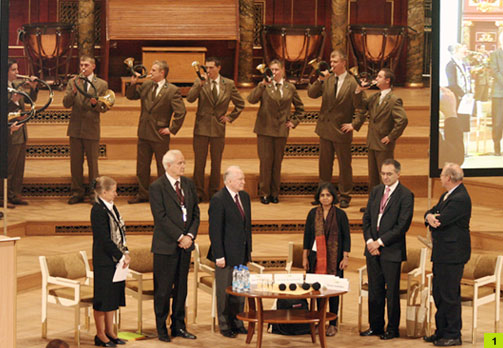
The Bali Action Plan acknowledged the importance of forests and initiated
a 2-year consultation process expected to culminate in an agreement that
will replace the Kyoto Protocol, which expires in 2012. Among other things,
the agreement is likely to include measures to reduce emissions from
deforestation and forest degradation, or REDD as it is known. Given that
deforestation and forest degradation currently account for around 20 per
cent of all global carbon emissions, REDD is about using financial
incentives to conserve forests. Linking such schemes to a global carbon
market, for example, could enable forest conservation to compete with the
economic drivers of deforestation, which currently favour destructive
logging practices and conversion of forest land to other uses. Financial
flows, it is anticipated, will go from developed to developing countries.
The halfway point on the road to Copenhagen, where the post-Kyoto agreement
will be finalised at COP 15, was COP 14, held in Poznań in December 2008.
Forest Day 2, hosted by CIFOR, CPF and the Polish government, proved a good
place to gauge how much progress had been made over the past year, not least
in terms of gaining a better understanding of how REDD will work.
The opening plenary of Forest Day 2 was followed by four sessions which
focused on a range of cross-cutting themes: the role of forests in
adaptation to climate change; addressing forest degradation through
sustainable forest management; capacity building for future REDD projects;
and options for integrating REDD into the new global climate regime.
A summary of the key messages that came out of these sessions was
delivered by Frances Seymour, CIFOR’s Director General, to Yvo de Boer,
Executive Secretary of the UNFCCC. See
http://www.cifor.cgiar.org/publications/pdf_files/cop/cop14/Summary-Forest-Day-2.pdf.
As well as the need for forests to be included in any future climate
regime, this summary emphasised the need for any such regime to reflect the
fact that forests are more than just carbon storehouses and, if properly
designed, a new global climate agreement can deliver enormous co-benefits
through forests. These co-benefits include poverty alleviation, biodiversity
conservation and strengthening of human rights.
Other key messages included the importance of climate change adaptation,
which has been poorly addressed in national strategies and international
negotiations, and the need to effectively address forest degradation (‘the
second D’), which in some parts of the world accounts for more carbon
emissions than deforestation.
The feedback on Forest Day 2, both from partners and from those who
attended the conference, was overwhelmingly positive.
‘Forest Day was a great forum for anybody like us who’s involved in the
trade in forest carbon, and anyone who wants to learn more about how forests
can contribute to climate change adaptation and mitigation,’ says Joanna
Durbin of the Climate, Community and Biodiversity Alliance. The Alliance
launched the latest edition of its standards at Forest Day, and it was one
of almost 40 organisations that hosted a side event.
CIFOR also organised a regional Forest Day for Central Africa in April
2008. This event was held in Yaoundé, Cameroon, and it brought together
researchers, non-governmental organisations, the private sector, forest
communities and government officials. It helped to raise awareness about the
role forests can play in mitigating climate change and the impact REDD
projects could have on forests and forest-dwelling communities in Central
Africa. See 'Central Africa gets its own Forest Day'
|